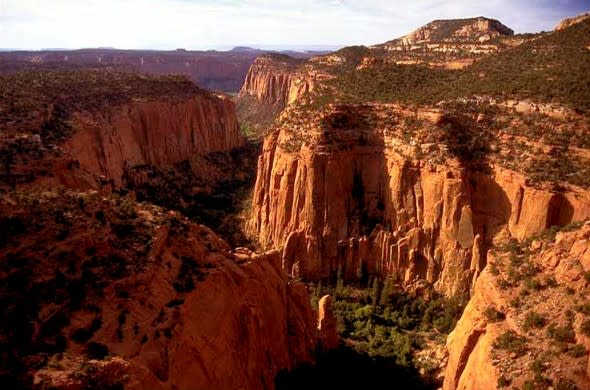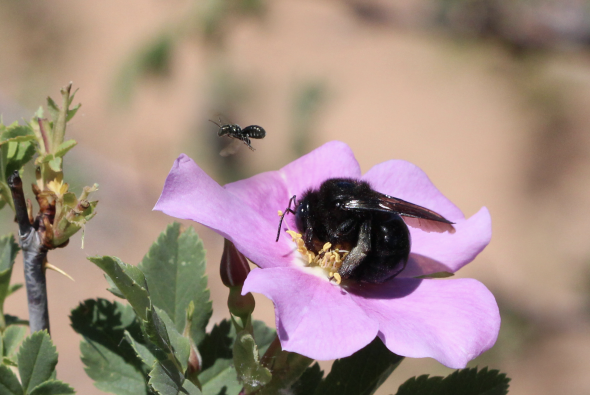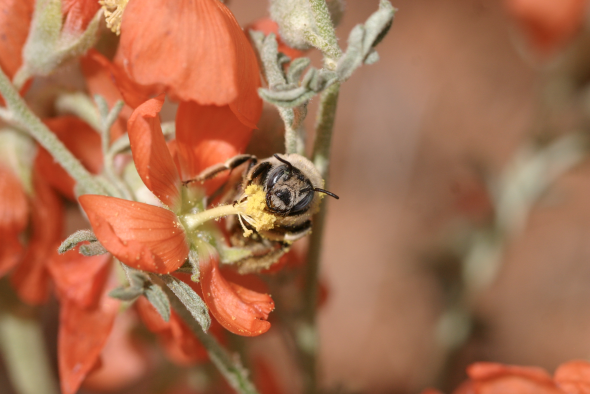Trump's decision to shrink size of Grand Staircase-Escalante National Monument could impact hundreds of bee species
Grand Staircase-Escalante National Monument is a federally protected area found in central southern Utah. It is about 1.9 million acres and one of the top locations for bee diversity in the United States.
However, it was reduced in size by President Donald Trump late in 2017 in a proclamation that turned one large monument into three smaller ones.
The monument was originally designated by President Bill Clinton in 1996, due to the land being home to "many different vegetative communities and numerous types of endemic plants and their pollinators."
At the time of the proclamation, it was unclear how many pollinators were in this area.

In this file photo, date unknown, the Upper Gulch section of the Escalante Canyons within Utah's Grand Staircase-Escalante National Monument features sheer sandstone walls, broken occasionally by tributary canyons. (AP Photo/Douglas C. Pizac, File)
Therefore, a handful of entomologists set out season after season to observe and classify wild bees throughout the monument. They found 660 species of known bees from the Grand Staircase, including 49 undescribed species, in a four-year study published Nov. 7, 2018.
The team includes Joseph S. Wilson, associate professor of biology at Utah State University; Olivia Messinger Carril, Ph.D. researcher and middle school science teacher; and Matt Kelly, author and editor of TheBeeReport.com.
There are nearly as many bee species in Grand Staircase as there are in the entire eastern U.S., where there are 750 species east of the Mississippi River.
"Even for Utah, which is a pretty diverse state for bees with over 1,000 species, Grand Staircase is a hotspot for bee diversity, with over half of the bees known from the state being found within its boundaries," the team said in an email to AccuWeather.
The exact reasons for this diversity are not entirely clear, although deserts and arid regions around the world are known for their high bee diversity. It is likely related to the high diversity of flowering plants, the long flowering season and the many habitats in the area.
This study described the rich bee community found in this area. While working on this study, a second study came about because the team heard rumors that the federal government had intentions to reduce the size of the national monument.
"As soon as the new proposed boundaries were released, we started working to see how these new boundaries would affect the bees," the team said.
The researchers conducted the second study, published on Dec. 4, 2018, to address the fact that the monument has now been cut almost in half and has been divided into three management units.

(Photo/Joseph Wilson and Olivia Messinger Carril)
They found that while 87 percent of the species known from the original monument are found within at least one of the three new management units, 84 species previously known from Grand Staircase-Escalante are no longer in monument boundaries.
While some of these 84 species are widespread across the West, others are unique to the area and represent range extensions.
The impact that Trump's proclamation will have on these 84 species is unclear, as it is unknown how the non-monument land will be used.
"These excluded bee populations might be threatened by increased development, tourism or mining activities," the team said.
Bees in general are highly localized. Even within Grand Staircase, most bee species were only found in a few locations.
"Bees cannot generally survive in all regions of the country, or even all regions within Grand Staircase. With the exception of some rather tolerant species, it would be difficult to try to relocate most bee communities," the team said.
There are over 4,000 bee species in the U.S. Each is unique, and very little is known about any but a handful.
Grand Staircase-Escalante represents a thoroughly sampled bee community, and there aren't many long-term studies like this in existence, especially in the U.S.
"If we are to protect ecosystem services, it is important to understand those services. Our work in Grand Staircase-Escalante National Monument is one piece in this puzzle that scientists are working to solve," the team said.

(Joseph Wilson and Olivia Messinger Carril)
There are increasing concerns that bee populations across the U.S. are declining due to various human activities, varroa mites, viruses and the mysterious yet seemingly increasing Colony Collapse Disorder (CCD).
However, it is difficult to know which species are in decline when scientists are still discovering new species. Continued research is needed to better understand this phenomenon.
"There are landscape-level changes that have been made that seem likely to affect bees: parking lots can't be good for ground nesting bees," the team said.
National monuments and national parks are great not just for the vast landscapes they protect, but for the tiny creatures, like bees, that can reside relatively undisturbed there, the team said.
In nearly every ecosystem on the planet, bees are among the most important pollinators. A healthy bee population can be crucial in maintaining a healthy ecosystem.
"Changes to the bee communities or the plant communities can have wide-ranging and complicated ripple effects," the team said.
However, the chances of all bees going away are very small, and the impacts depend on which bees are hurt and which flowers they visit.
"Some bees would benefit from the absence of some of the others because there would be less competition. Some flowers would set less seed in the absence of the bees that do most of the pollinating, etc.," the team said.
It is unclear what will happen now that these areas aren't protected as national monument lands.
"Perhaps the bees and the pollination services they provide will be fine; perhaps not. The question is, really, do we want to find out? Maybe it would be best to consider the pollinators and proceed with caution as we use these lands," the team said.
They are still federal Bureau of Land Management (BLM) lands. The BLM is required to conduct environmental assessments, which may consider pollinators.
"Our recommendation is really that the BLM remembers to include pollinators as they consider how they will be using the lands both inside and outside the monument," the team said.

